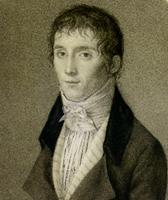

Niepce's 8 hour exposure made with a camera obscura and pewter coated with bitumen (an asphalt that hardened when exposed to light) from 1826. Keep in mind that Niepce had been working on obtaining a permanent photograph since the late 1700s so it took him a good 30 years or so of work to create his early permanent photographs (which he referred to as heliographs, "sun writings")

Daguerre (pictured above) and the invention of the Daguerreotype: With the Daguerreotypes, images were exposed directly onto a mirror-polished surface of silver bearing a coating of silver halide particles deposited by iodine vapor. (As time went on he started working with other chemicals such as bromine which resulted in shorter exposures) The daguerreotype is a negative image but the mirrored surface of the metal plate reflects the image and makes it appear positive in the proper light. The Daguerreotype was a direct photo process which was unable to be duplicated, meaning 1 final image was all you were going to get.

Daguerreoype of Edgar Allan Poe from the 1840s

early Daguerreotype kit

Advertisement for traveling Daguerreotype photographer E.S. Hayden.
Here is a cool website called the Dag Lab that goes into further explanation of the process of making Daguerreotypes.
The Getty Museum site has some interesting videos as well.



1 comment:
The website you link to at the end of your page has been moved, this is the place i was redirected to "http://www.thedaglab.com/daguerreotype-process-details/" Just giving you the heads uo so you can update it.
Post a Comment